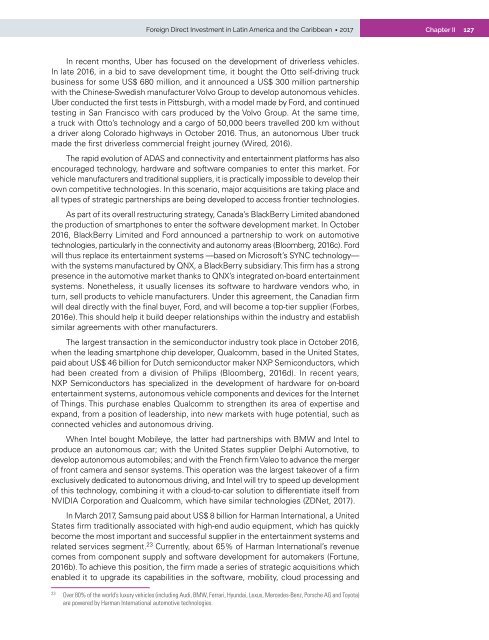Foreign Direct Investment in Latin America and the Caribbean 2017
This publication sets out and analyses the main foreign direct investment (FDI) trends in the countries of Latin America and the Caribbean. The 2017 edition shows that the region is at a difficult juncture. FDI inflows declined by 7.9% in 2016, to US$ 167.043 billion, representing a cumulative fall of 17.0% since the peak in 2011. The fall in commodity prices continues to affect investments in natural resources, sluggish economic growth in several countries has slowed the flow of market-seeking capital, and the global backdrop of technological sophistication and expansion of the digital economy has concentrated transnational investments in developed economies.
This publication sets out and analyses the main foreign direct investment (FDI) trends in the countries of Latin America and the Caribbean. The 2017 edition shows that the region is at a difficult juncture. FDI inflows declined by 7.9% in 2016, to US$ 167.043 billion, representing a cumulative fall of 17.0% since the peak in 2011. The fall in commodity prices continues to affect investments in natural resources, sluggish economic growth in several countries has slowed the flow of market-seeking capital, and the global backdrop of technological sophistication and expansion of the digital economy has concentrated transnational investments in developed economies.
You also want an ePaper? Increase the reach of your titles
YUMPU automatically turns print PDFs into web optimized ePapers that Google loves.
<strong>Foreign</strong> <strong>Direct</strong> <strong>Investment</strong> <strong>in</strong> Lat<strong>in</strong> <strong>America</strong> <strong>and</strong> <strong>the</strong> <strong>Caribbean</strong> • <strong>2017</strong><br />
Chapter II<br />
127<br />
In recent months, Uber has focused on <strong>the</strong> development of driverless vehicles.<br />
In late 2016, <strong>in</strong> a bid to save development time, it bought <strong>the</strong> Otto self-driv<strong>in</strong>g truck<br />
bus<strong>in</strong>ess for some US$ 680 million, <strong>and</strong> it announced a US$ 300 million partnership<br />
with <strong>the</strong> Ch<strong>in</strong>ese-Swedish manufacturer Volvo Group to develop autonomous vehicles.<br />
Uber conducted <strong>the</strong> first tests <strong>in</strong> Pittsburgh, with a model made by Ford, <strong>and</strong> cont<strong>in</strong>ued<br />
test<strong>in</strong>g <strong>in</strong> San Francisco with cars produced by <strong>the</strong> Volvo Group. At <strong>the</strong> same time,<br />
a truck with Otto’s technology <strong>and</strong> a cargo of 50,000 beers travelled 200 km without<br />
a driver along Colorado highways <strong>in</strong> October 2016. Thus, an autonomous Uber truck<br />
made <strong>the</strong> first driverless commercial freight journey (Wired, 2016).<br />
The rapid evolution of ADAS <strong>and</strong> connectivity <strong>and</strong> enterta<strong>in</strong>ment platforms has also<br />
encouraged technology, hardware <strong>and</strong> software companies to enter this market. For<br />
vehicle manufacturers <strong>and</strong> traditional suppliers, it is practically impossible to develop <strong>the</strong>ir<br />
own competitive technologies. In this scenario, major acquisitions are tak<strong>in</strong>g place <strong>and</strong><br />
all types of strategic partnerships are be<strong>in</strong>g developed to access frontier technologies.<br />
As part of its overall restructur<strong>in</strong>g strategy, Canada’s BlackBerry Limited ab<strong>and</strong>oned<br />
<strong>the</strong> production of smartphones to enter <strong>the</strong> software development market. In October<br />
2016, BlackBerry Limited <strong>and</strong> Ford announced a partnership to work on automotive<br />
technologies, particularly <strong>in</strong> <strong>the</strong> connectivity <strong>and</strong> autonomy areas (Bloomberg, 2016c). Ford<br />
will thus replace its enterta<strong>in</strong>ment systems —based on Microsoft’s SYNC technology—<br />
with <strong>the</strong> systems manufactured by QNX, a BlackBerry subsidiary. This firm has a strong<br />
presence <strong>in</strong> <strong>the</strong> automotive market thanks to QNX’s <strong>in</strong>tegrated on-board enterta<strong>in</strong>ment<br />
systems. None<strong>the</strong>less, it usually licenses its software to hardware vendors who, <strong>in</strong><br />
turn, sell products to vehicle manufacturers. Under this agreement, <strong>the</strong> Canadian firm<br />
will deal directly with <strong>the</strong> f<strong>in</strong>al buyer, Ford, <strong>and</strong> will become a top-tier supplier (Forbes,<br />
2016e). This should help it build deeper relationships with<strong>in</strong> <strong>the</strong> <strong>in</strong>dustry <strong>and</strong> establish<br />
similar agreements with o<strong>the</strong>r manufacturers.<br />
The largest transaction <strong>in</strong> <strong>the</strong> semiconductor <strong>in</strong>dustry took place <strong>in</strong> October 2016,<br />
when <strong>the</strong> lead<strong>in</strong>g smartphone chip developer, Qualcomm, based <strong>in</strong> <strong>the</strong> United States,<br />
paid about US$ 46 billion for Dutch semiconductor maker NXP Semiconductors, which<br />
had been created from a division of Philips (Bloomberg, 2016d). In recent years,<br />
NXP Semiconductors has specialized <strong>in</strong> <strong>the</strong> development of hardware for on-board<br />
enterta<strong>in</strong>ment systems, autonomous vehicle components <strong>and</strong> devices for <strong>the</strong> Internet<br />
of Th<strong>in</strong>gs. This purchase enables Qualcomm to streng<strong>the</strong>n its area of expertise <strong>and</strong><br />
exp<strong>and</strong>, from a position of leadership, <strong>in</strong>to new markets with huge potential, such as<br />
connected vehicles <strong>and</strong> autonomous driv<strong>in</strong>g.<br />
When Intel bought Mobileye, <strong>the</strong> latter had partnerships with BMW <strong>and</strong> Intel to<br />
produce an autonomous car; with <strong>the</strong> United States supplier Delphi Automotive, to<br />
develop autonomous automobiles; <strong>and</strong> with <strong>the</strong> French firm Valeo to advance <strong>the</strong> merger<br />
of front camera <strong>and</strong> sensor systems. This operation was <strong>the</strong> largest takeover of a firm<br />
exclusively dedicated to autonomous driv<strong>in</strong>g, <strong>and</strong> Intel will try to speed up development<br />
of this technology, comb<strong>in</strong><strong>in</strong>g it with a cloud-to-car solution to differentiate itself from<br />
NVIDIA Corporation <strong>and</strong> Qualcomm, which have similar technologies (ZDNet, <strong>2017</strong>).<br />
In March <strong>2017</strong>, Samsung paid about US$ 8 billion for Harman International, a United<br />
States firm traditionally associated with high-end audio equipment, which has quickly<br />
become <strong>the</strong> most important <strong>and</strong> successful supplier <strong>in</strong> <strong>the</strong> enterta<strong>in</strong>ment systems <strong>and</strong><br />
related services segment. 23 Currently, about 65% of Harman International’s revenue<br />
comes from component supply <strong>and</strong> software development for automakers (Fortune,<br />
2016b). To achieve this position, <strong>the</strong> firm made a series of strategic acquisitions which<br />
enabled it to upgrade its capabilities <strong>in</strong> <strong>the</strong> software, mobility, cloud process<strong>in</strong>g <strong>and</strong><br />
23<br />
Over 80% of <strong>the</strong> world’s luxury vehicles (<strong>in</strong>clud<strong>in</strong>g Audi, BMW, Ferrari, Hyundai, Lexus, Mercedes-Benz, Porsche AG <strong>and</strong> Toyota)<br />
are powered by Harman International automotive technologies.


















